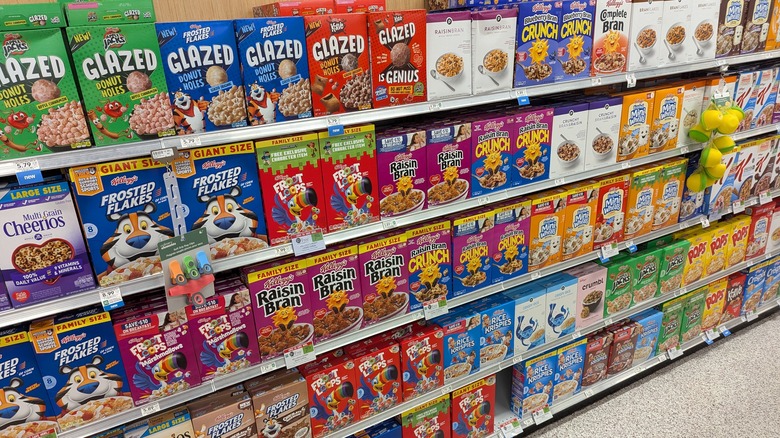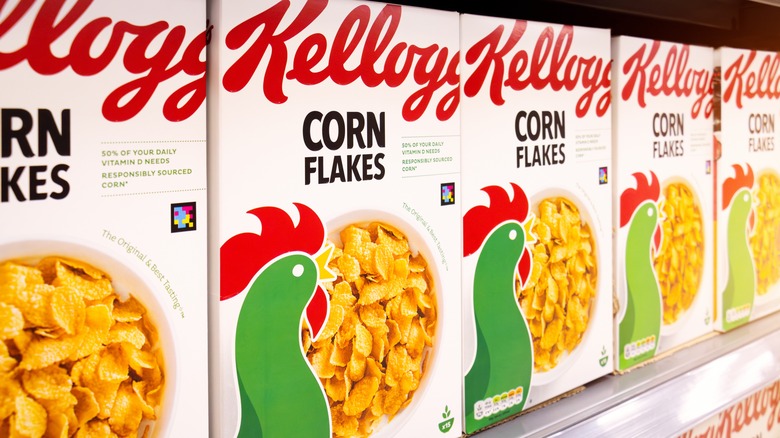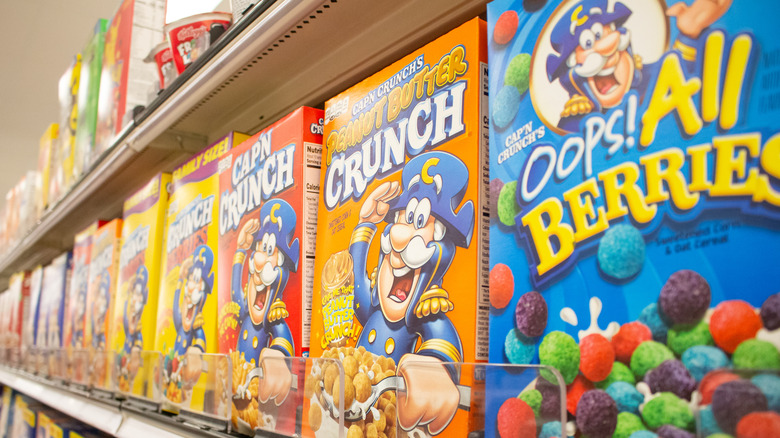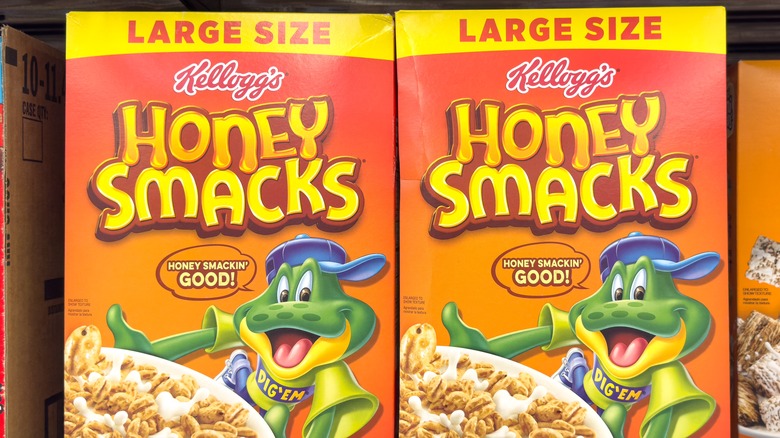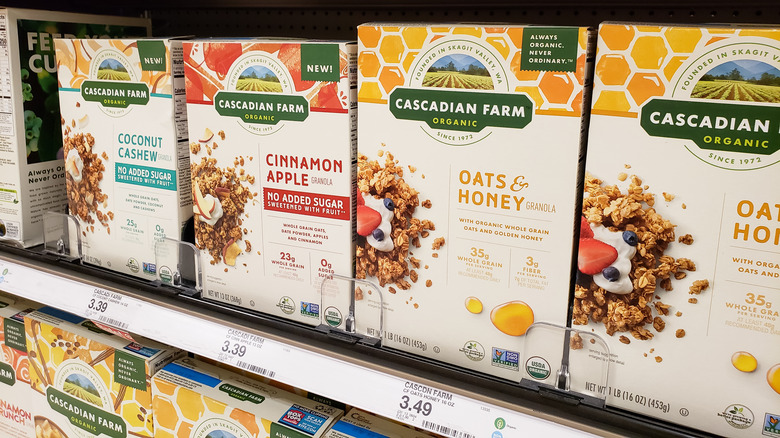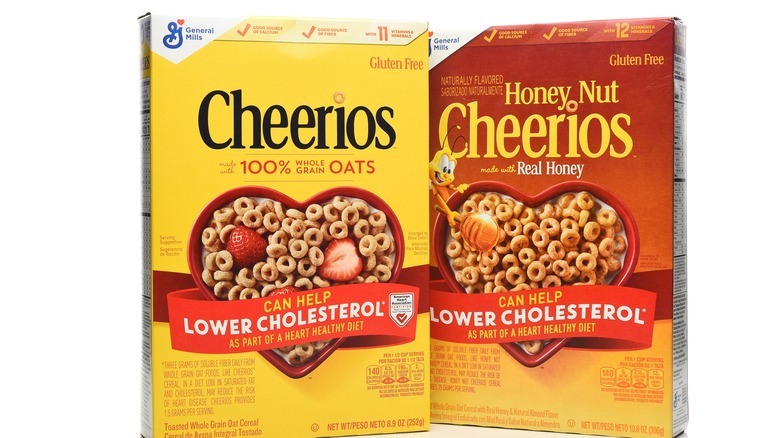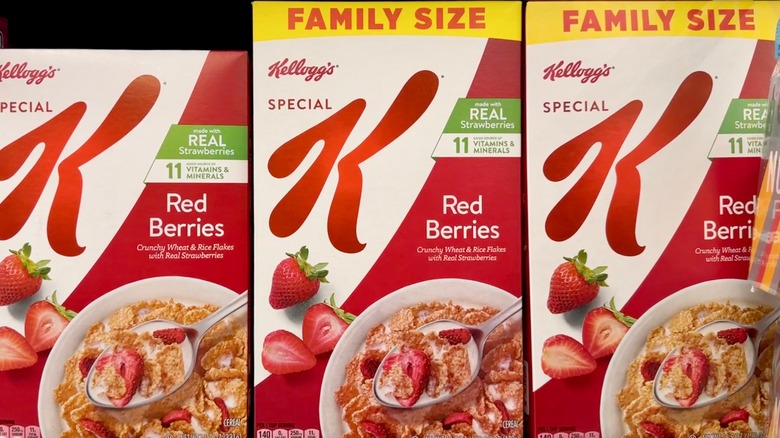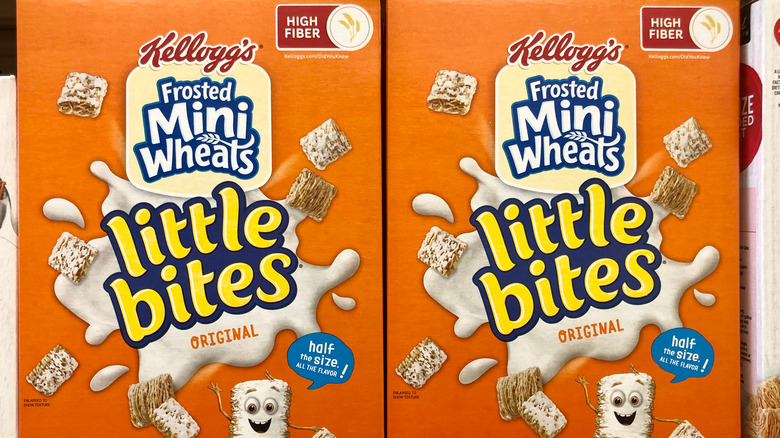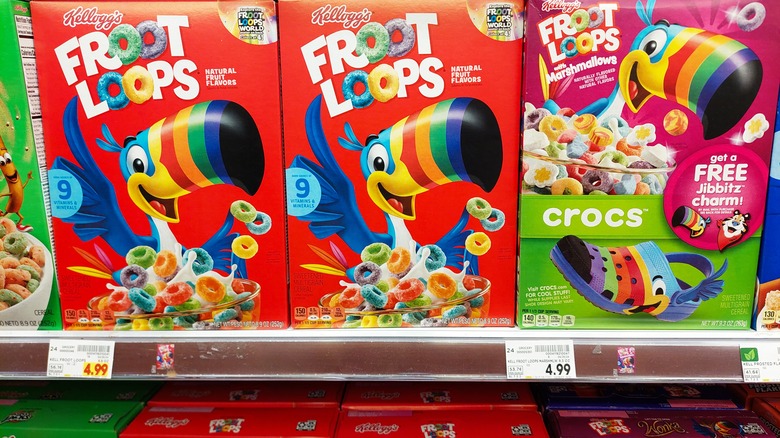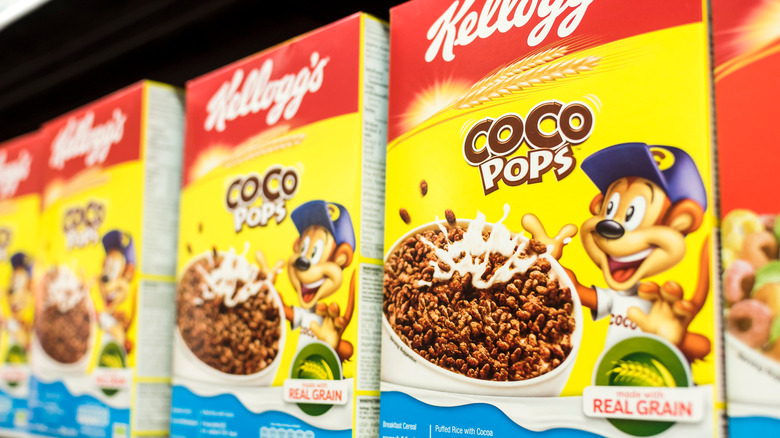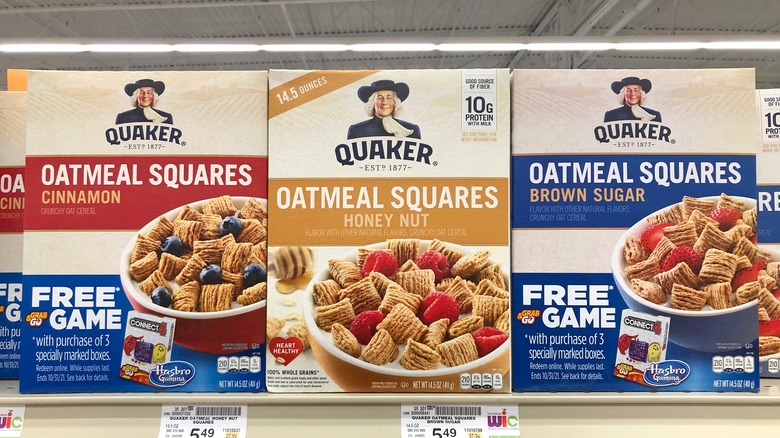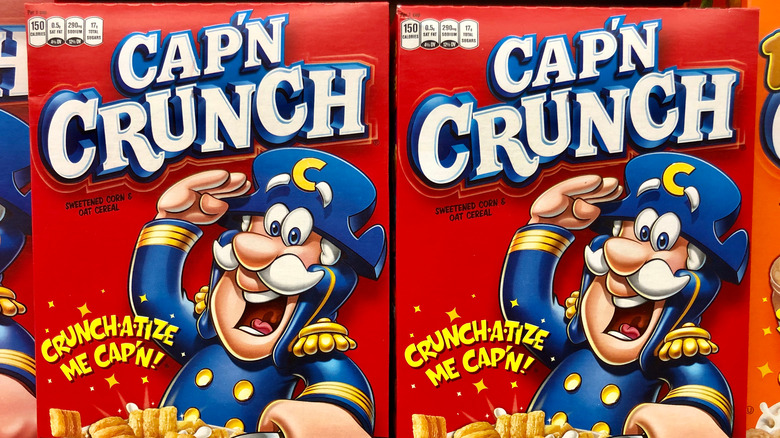Cereal Recalls That Affected Millions
When you hear the word cereal, what comes to mind? For many of us, it stirs up memories of our childhood. Maybe it's curling up on the couch with your siblings, a bowl full of Lucky Charms in hand, watching your favorite Saturday morning cartoons. Or the thrill — or disappointment — of hearing that cereal was on the menu for dinner. Maybe you raced to be the first to open the box of Frosted Flakes and lay claim to the cool toy inside. Whatever the memory, cereal has a way of bringing the past rushing back.
But not all cereal memories are sweet. The cereal business itself has seen its share of ups and downs, leaving many to worry that breakfast cereal faces dark days ahead. Prior to the COVID-19 pandemic, cereal sales dipped as consumers opted for grabbing breakfast on the go or fresher, healthier, protein-packed options. During the COVID-19 pandemic, as people ate at home more and shopped for shelf-stable foods, cereal boxes found their way back into shopping carts.
Still, even as business rebounded, some cereal brands have faced challenges of a different kind: product recalls. Over the years, some favorite brands have made headlines, not for their latest flavor launch or a healthy twist, but for safety concerns. From manufacturing mistakes to food-borne illnesses, the cereal market has been plagued with many recalls. Let's explore some of the not-so-sweet memories of the most significant recalls in cereal history.
Kellogg's recalled European cereal over choking risk (2024)
Sometimes cereal is just too chunky to soak up the milk. This was the case that prompted a voluntary recall of Kellogg's Corn Flakes Chocolate Flavour by Kellogg's European maker, Kellanova, in May 2024. Consumers complained of large, hard cereal chunks that didn't break down when mixed with milk. The Food Standards Agency, Europe's equivalent to the U.S. Food and Drug Administration (FDA), deemed the potential chunk-laden cereal unsafe to eat, concerned that it could pose a dental or choking hazard. "It's important to say that the risk of injury from these hard lumps of chocolate cereal is minimal but we're not willing to compromise on quality or safety," a Kellanova spokesperson said in a statement.
Boxes of the chocolatey corn flakes with best by dates between June 12, 2024 and April 12, 2025 were recalled, forcing stores to screen their shelves and consumers to check the dates if they had this cereal on their pantry shelves. The company did offer refunds for the cost of the chocolatey corn flakes. Fortunately, the recall didn't affect Kellogg's oldest cereal, Corn Flakes, which already has a rather storied past.
Quaker Oats recalled cereal items due to salmonella (2023)
Quaker Oats had to pull many breakfast items, including two of its popular granola and cereals, off shelves in late 2023 due to potential contamination with salmonella. The initial recall, in December that year, impacted 40 Quaker products, including its popular chewy granola bars and snack mixes, as well as cereal varieties of granola oats and Quaker puffs. Just a few weeks later, in January 2024, Quaker extended the recall to more bars and snacks, as well as three varieties of Cap'n Crunch cereals, including Cinnamon Crunch, OOPS! All Berries, and Sea Berry Crunch brands.
Salmonella is a bacteria that can be found in packaged foods, like cereals, and can cause nausea, diarrhea, cramping, and headaches. There were no confirmed reports of illnesses associated with this recall, but it did take a bite out of Quaker's business. The salmonella was traced back to a 65-year-old Quaker plant in Danville, Illinois, which was shut down in June 2024 after sales and profits dropped with the fallout from the recall.
Kellogg's recalled Honey Smacks due to salmonella (2018)
Kellogg Co. found itself in a sticky situation when its Honey Smacks cereal was linked with a food poisoning outbreak that sickened more than 135 people across 36 states. It was June 2018 when the FDA issued a recall of the breakfast cereal amid speculation that salmonella was causing the illness. Nearly three dozen people were hospitalized after allegedly eating Honey Smacks. While no deaths occurred, salmonella can be fatal, and especially serious for elderly, young children, and those with compromised immune systems.
Boxes of Honey Smacks, carrying the notable frog mascot, were removed from store shelves, and didn't return for nearly four months. Meanwhile, the CDC had to plead with Honey Smacks fans to stop eating the breakfast cereal and throw it away. But the story didn't end there. An investigation traced the salmonella to a manufacturing facility run by Kerry, Inc. in Gridley, IL. Prior to the recall, salmonella had been detected in routine testing at that plant more than 80 times. Not only did plant employees fail to clean up their act or the facility, they didn't report the unsanitary conditions and violations to Kellogg's. In what's become the largest ever food safety find and forfeiture case, Kerry agreed to pay a whopping $19.2 million settlement.
General Mills recalled granola over nut cross contamination (2017)
Due to the high incidence of food allergies, the FDA requires food manufacturers to declare ingredients on packages, including any type of tree nut. General Mills failed to do that when some almonds got mixed in with the brand's Cascadian Farm Organic Cinnamon Raisin Granola Cereal. It's not clear if any granola eaters discovered the nuts, or if it was cross-contamination from another product manufactured in the same plant.
Regardless, General Mills issued a voluntary recall in July 2017 for boxes that were produced on two specific dates in July, and all boxes were removed from store and warehouse shelves. Consumers with nut allergies were warned to avoid consuming any boxes that had specific "Best by" dates. The company also offered a full refund or a nut-free replacement. Fortunately, there were no known reports of illness or deaths associated with this cereal recall.
The FDA takes nut monitoring very seriously. Over 20 years ago, nut disclosure was put into law with the Food Allergen Labeling and Consumer Protection Act of 2004. The law identifies eight food allergen groups: milk, eggs, fish, crustacean shellfish, tree nuts, peanuts, wheat, and soybeans, and authorizes the FDA to inspect and sample foods for allergen-protection adherence, and recall products and push consumer alerts when problems arise.
Varieties of Cheerios recalled for wheat flour (2015)
Have you ever wondered what it's like to work at a Cheerio's plant? Yeah, us neither, but it must be quite a busy and memorable experience. Every week, they produce and ship a half million cases of the famously-yellow boxes of O-shaped oat, and people who live in the cities where these facilities are located say there's an unmistakable Cheerios smell in the air.
One such plant in Lodi, California must have been especially busy in July 2015 when wheat flour was accidentally used in making a batch of Cheerios and Honey Nut Cheerios, forcing General Mills to issue a recall of 1.8 million boxes. Fortunately, it only affected two flavors of Cheerios, because there are actually way more Cheerios flavors than you may know.
Cheerios are supposed to be made with two simple ingredients — gluten-free oat and corn flour, making the cereal safe for those who have a wheat allergy or celiac disease. This is why the cereal is marketed as gluten-free. After the recall, General Mills warned consumers with these allergies not to consume boxes noted with specific "Best Used by" dates, and cleared them from store and warehouse shelves. People with gluten allergies or intolerances can suffer from gastrointestinal issues, brain fog, vomiting, and long-term intestinal damage.
Kellogg's recalled berry-flavored Special K after glass pieces discovered (2013)
Crunchy is definitely a term that's used to describe nearly every type of cereal — at least at the pre-milk soaking stage. Most of us assume that crunch is coming from actual pieces of cereal, or maybe the freeze-dried marshmallows or berries, chopped nuts or other added ingredients. But in 2013, consumers of Kellogg's popular Special K Red Berries were surprised when the source of the crunch turned out to be pieces of glass instead of cereal.
Fortunately no injuries were reported in this particular incident, but Kellogg's ended up recalling 36,000 boxes of the cereal due to the possibility of glass fragments. Three sizes of the cereal were recalled and removed from store and warehouse shelves. "The company took this precautionary action due to the possible presence of glass fragments from a single batch of one of the ingredients," a company spokesperson said in an interview with Reuters. "This is a very small recall... We took the step out of an abundance of caution." To fully understand the context of why having glass mixed in with a food product would be considered minor, you need context to compare it to the more significant ones Kellogg's had been dealing with in prior years to understand. Keep reading to catch up.
Oddly, recalls for glass fragments mixing with food aren't highly unusual. Earlier this year, Upper Crust Hill Bakery had to recall bread and rolls for glass fragments that were accidentally baked in, and in 2016, nut-maker Emerald had to recall roasted and salted cashews when a consumer discovered the crunch wasn't from a nut but from a small piece of glass.
Kellogg's recalled 3 million boxes of frosted cereal containing metal (2012)
A non-food item was to blame again in another one of Kellogg's recalls that affected millions when metal-mesh pieces were found in boxes of Frosted Mini Wheats. Kellogg's issued a voluntary recall of 3 million boxes of Frosted Mini Wheats Bite Size Original and Mini-Wheats Unfrosted Bite Size.
It's believed that the metal mixup happened because of faulty equipment at a cereal production facility where some of the flexible metal mesh pieces broke off a machine while the cereal was being processed. While the company consulted with an internal medicine physician in an attempt to calm the public, insisting that the likelihood of metal making its way into food is extremely low, as is the risk of injury. This didn't actually quell concerns among consumers, and instead they took their complaints online, posting videos of magnets picking up cereal bits, and one who submitted a photo to the HuffPost with the alleged metal piece beside some cereal bits, claiming it had been discovered in his daughter's mouth. No consumer injuries were reported, but Kellogg's bank account didn't fare so well. This incident cost them somewhere between $20 million and $30 million.
Kellogg's recalled several cereals over packaging chemical (2010)
Box design, ingredients, shape, and flavors vary greatly across cereal varieties. But also the smell — most of us can associate a certain smell with our favorite breakfast cereal. For some, it might be the toasty but sweet smell of Cheerios or the gummy-candy like scent of Fruit Loops. But it wasn't a pleasant, nostalgic smell, but an odd odor that emerged when consumers opened boxes of Fruit Loops, Corn Pops, Honey Smacks, and Apple Jacks, which prompted a massive recall for Kellogg's.
In June 2010, the company issued a voluntary recall of 28 million boxes of these cereals due to an "uncharacteristic off-flavor and smell"; meanwhile, consumers blatantly described the smell and taste as "foul," "weird," "stale," and "stinky." Besides unappetizing, some unlucky cereal consumers reported nausea and diarrhea associated with the affected cereals; Kellogg's claimed the risk of serious illness was low. Package liners in the cereal boxes were to blame. About a month after issuing the recall, Kellogg's said that "elevated levels of hydrocarbons, including methylnaphthalene," used in liners were the source of the smell and flavor oddities. Kellogg's located and destroyed the problematic liner material, but a Congressional oversight committee demanded the company hand over all internal documents related to the chemical and its company safety procedures, and its revenue that quarter fell 4%.
Kellogg's Coco Pops and Rice Bubbles (2004)
Apparently wire from manufacturing machinery isn't an issue exclusive to the United States. In 2004, Kellogg recalled two cereals in Australia and New Zealand after small pieces of stainless steel wire were found in some boxes. This recall only affected packs of Coco Pops and Rice Bubbles with "best by" dates of three days. Consumers could return the recalled cereal to the store they bought it from, or the company's customer service, and receive a full refund.
If you're wondering what exactly Coco Pops and Rice Bubbles are, think Krispies with Coco Pops being the Down Under's version of Cocoa Krispies, and Rice Bubbles, the equivalent of Rice Krispies. Despite what the "Snap, Crackle, and Pop" slogan might suggest, metal wasn't involved. The catchy campaign was designed to set Rice Krispies apart from soggy, mushy competitors by highlighting how the cereal stays puffed, crunchy, and floats in milk.
In 2023, the Kellogg brand snapped, crackled, and pop itself, splitting into two new companies. Kellanova took over the Kellogg brand in Australia and New Zealand, joining other non-U.S. markets, as well as the global snacking product line and the noodle business. The U.S.-based cereal business was rebranded to WK Kellogg after the company's founder, William Keith Kellogg.
Quaker recalled oatmeal cereal for nut contamination (2003)
Walking down the colorful stacked cereal aisle, have you ever wondered who the man with the hat and white curly hair on the Quaker Oats label is? Many assume he's the founder, but he actually is more of a brand icon than a real person. Quaker is deemed by some as the original standout in cereal marketing, thanks in part to its iconic cylindrical cardboard packaging featuring a no-name Quaker figure designed to represent the brand's core values of honesty, integrity, and strength.
But Quaker's honesty pillar was compromised in 2003 when it didn't disclose almonds were mixed in with its Quaker Oatmeal Sugar Bliss, prompting a massive recall. This cross-contamination or mislabeling mishap cost Quaker a lot in terms of both profit and brand. More than 23,000 cases of the individual instant oatmeal cups were pulled from warehouses and shelves, and consumers were warned to throw away any on their shelves, especially those with nut allergies. The production of the affected heat-and-eat convenient cups of cereal was traced back to a Quaker plant in Sparks, Nevada, where a machine that had previously been used for nut-containing products, was likely re-used for the oatmeal batch without proper cleaning. What would the Quaker man say about that?
Quaker recalled cereal over toy caused injuries (1993)
Now that we know about the famous face of Quaker's oatmeal, let's explore another one of the brand's mystery men: Cap'n Crunch. Created in 1963 by the creators of Rocky and Bullwinkle, Cap'n Crunch, aka Horatio Magellan Crunch, was designed to build a sense of adventure to kids' breakfast tables. Born on the whimsical Crunch Island, surrounded by a sea of milk, and home to the towering mountain of cereal, Mount Crunchmore, he famously captained the S.S. Guppy to deliver his sweet cereal treasure. The original television commercials, part of a $5 million launch campaign, featured Cap'n proudly declaring: "It's got corn for crunch, oats for punch, and it stays crunchy, even in milk."
Decades later, the fun hit a snag when Quaker was forced to recall boxes of Cap'n Crunch, Crunchberries, and Peanut Butter Crunch in 1993 after a toy surprise inside began injuring kids. The "popper" toy that caused the recall of 8.3 million boxes of cereal was basically a half-sphere piece of flexible plastic that when inverted and suctioned to a surface would pop back up to its original shape. But kids being kids didn't just suction the toy to the breakfast table, instead they chose their arms, legs, a sister's check (you get the gist) resulting in 36 injuries, including bruising and bloodshot eyes.
